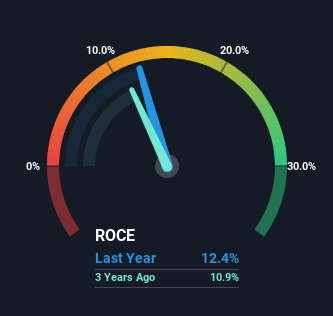- India
- /
- Electric Utilities
- /
- NSEI:POWERGRID
Investors Will Want Power Grid Corporation of India's (NSE:POWERGRID) Growth In ROCE To Persist
What trends should we look for it we want to identify stocks that can multiply in value over the long term? Firstly, we'd want to identify a growing return on capital employed (ROCE) and then alongside that, an ever-increasing base of capital employed. This shows us that it's a compounding machine, able to continually reinvest its earnings back into the business and generate higher returns. So when we looked at Power Grid Corporation of India (NSE:POWERGRID) and its trend of ROCE, we really liked what we saw.
Return On Capital Employed (ROCE): What Is It?
For those who don't know, ROCE is a measure of a company's yearly pre-tax profit (its return), relative to the capital employed in the business. To calculate this metric for Power Grid Corporation of India, this is the formula:
Return on Capital Employed = Earnings Before Interest and Tax (EBIT) ÷ (Total Assets - Current Liabilities)
0.12 = ₹268b ÷ (₹2.5t - ₹344b) (Based on the trailing twelve months to June 2024).
Thus, Power Grid Corporation of India has an ROCE of 12%. On its own, that's a standard return, however it's much better than the 5.9% generated by the Electric Utilities industry.
See our latest analysis for Power Grid Corporation of India

Above you can see how the current ROCE for Power Grid Corporation of India compares to its prior returns on capital, but there's only so much you can tell from the past. If you'd like to see what analysts are forecasting going forward, you should check out our free analyst report for Power Grid Corporation of India .
The Trend Of ROCE
Power Grid Corporation of India is showing promise given that its ROCE is trending up and to the right. The figures show that over the last five years, ROCE has grown 26% whilst employing roughly the same amount of capital. So it's likely that the business is now reaping the full benefits of its past investments, since the capital employed hasn't changed considerably. The company is doing well in that sense, and it's worth investigating what the management team has planned for long term growth prospects.
In Conclusion...
As discussed above, Power Grid Corporation of India appears to be getting more proficient at generating returns since capital employed has remained flat but earnings (before interest and tax) are up. And with the stock having performed exceptionally well over the last five years, these patterns are being accounted for by investors. With that being said, we still think the promising fundamentals mean the company deserves some further due diligence.
If you want to continue researching Power Grid Corporation of India, you might be interested to know about the 2 warning signs that our analysis has discovered.
For those who like to invest in solid companies, check out this free list of companies with solid balance sheets and high returns on equity.
New: Manage All Your Stock Portfolios in One Place
We've created the ultimate portfolio companion for stock investors, and it's free.
• Connect an unlimited number of Portfolios and see your total in one currency
• Be alerted to new Warning Signs or Risks via email or mobile
• Track the Fair Value of your stocks
Have feedback on this article? Concerned about the content? Get in touch with us directly. Alternatively, email editorial-team (at) simplywallst.com.
This article by Simply Wall St is general in nature. We provide commentary based on historical data and analyst forecasts only using an unbiased methodology and our articles are not intended to be financial advice. It does not constitute a recommendation to buy or sell any stock, and does not take account of your objectives, or your financial situation. We aim to bring you long-term focused analysis driven by fundamental data. Note that our analysis may not factor in the latest price-sensitive company announcements or qualitative material. Simply Wall St has no position in any stocks mentioned.
About NSEI:POWERGRID
Power Grid Corporation of India
An electric power transmission utility, engages in the power transmission business in India and internationally.
Undervalued average dividend payer.
Market Insights
Community Narratives



